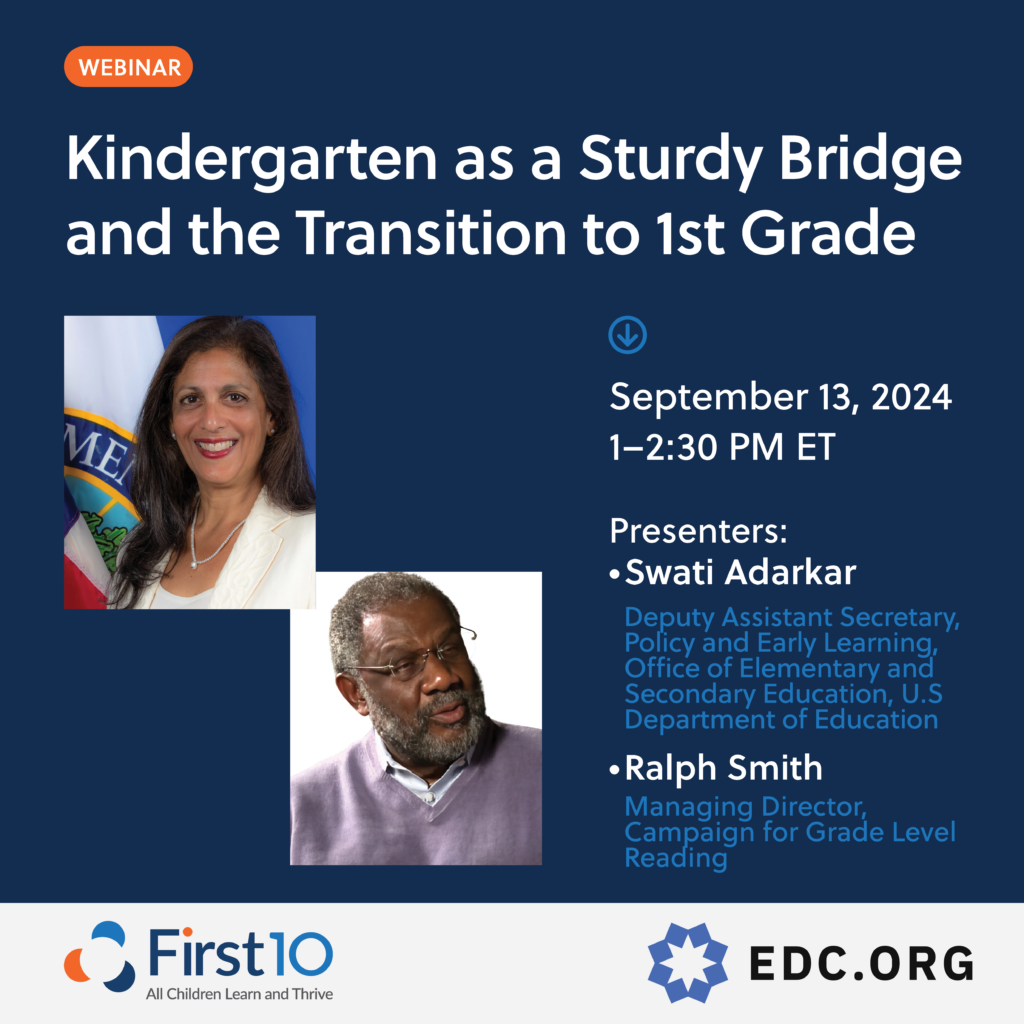Each month, First 10 communities from across the U.S. come together to share best practices at First 10 Network Meetings. In September, we were joined by two special guests: Swati Adarkar, Deputy Assistant Secretary of Policy and Early Learning at the U.S. Department of Education (ED), and Ralph Smith, Managing Director at the Campaign for Grade Level Reading (CGLR).
Adarkar and Smith both highlighted that children are entering kindergarten with literacy and other skill gaps that widen throughout the kindergarten year. To address these gaps, there must be an effective transition to kindergarten that sets students up for success in their academic careers. Additionally, children are entering kindergarten from a variety of settings in our mixed-delivery early childcare system with a wide range of linguistic and social strengths and needs. The kindergarten year offers a critical opportunity to nurture student assets and address their needs early on.
The U.S. Department of Education (ED) is prioritizing the transition to kindergarten and first grade as part of a larger effort to create a more equitable foundation for the educational success for all students. Adarkar explains that kindergarten is important for long-term student success because it is the first at-scale early learning opportunity in a school setting for providing the supports and interventions needed to assure on track development. Kindergarten is also a key inflection point for early learning, early school success, and equity. The transition to kindergarten presents an important opportunity to partner with parents and families to build the relationships, routines, and habits that are essential to early school success and everyday school attendance.
The Kindergarten Sturdy Bridge Learning Community was developed as part of ED’s efforts to focus attention and resources on children when they enter school for the first time. ED developed a set of enabling conditions for success that guide the work being done with states, district, schools, and community partners around the transition to kindergarten:
- An equity lens that focuses attention and resources on the most vulnerable populations of children
- Intentional and systematic alignment for continuity of services, supports, instruction, relationships, and data-sharing across the Pre-K-3 continuum
- Evidence-based, promising, and innovative models of instructional and assessment practices
- Professional development and supports for early educators, teachers, school leaders, and staff
- Authentic partnerships with parents, caregivers, and families
- Interagency, cross-sector, and community-wide collaboration that engages other public agencies, higher education, civic, community, private-sector, and social-sector stakeholders
- Strategic braiding and layering of funding streams to facilitate equity, alignment, and collaboration.
Smith outlined the CGLR’s 2024 priorities which directly align to ED’s conditions for success for the transition to kindergarten:
- Nurture a demand for smart decisions to accelerate equitable academic recovery and early school success
- Collaborate across sectors to create an abundance of out-of-school learning rich environments
- Partner with parents to advance the learning, development and well-being of their children.
Many First 10 communities are effectively implementing these enabling conditions and priorities to support the transition to kindergarten. The Detroit Leadership Academy First 10 Partnership consistently and intentionally solicits and leverages feedback from families. They organize responsive school-connected play and learns for students and their families that address events in the community. Another example is the York City First 10 Partnership, which offers guided play centers in kindergarten and focuses on collaboration across early grades through joint professional development and other initiatives. .
Along with strengthening kindergarten, it is also important to create an effective transition to first grade. Adarkar and Smith had the opportunity to hear from First 10 network members on how they are currently supporting the transition to kindergarten and first grade for both children and their families.
Some promising ideas to support the transition to first grade that also leverage the principles Adarkar and Smith named include having kindergarten and first grade teacher collaboration and creating family orientation activities. Network meeting attendees also shared out additional ideas to support the transition to first grade. One idea was to encourage kindergarten teachers to do “warm handoffs” with first grade teachers by meeting with them to provide information about students as well their families. Another idea was to support families in the transition to first grade through home visits or meet-ups to foster stronger partnerships with families. These kinds of visits are most often conducted by childcare providers and preschool teachers prior to kindergarten, so maintaining these visits through first grade could help families adjust as their child progresses from one grade to the next.
Understanding the importance of the kindergarten and first grade years can drive intentional decision making and systemic supports that set up children and their families for success in kindergarten and beyond.
